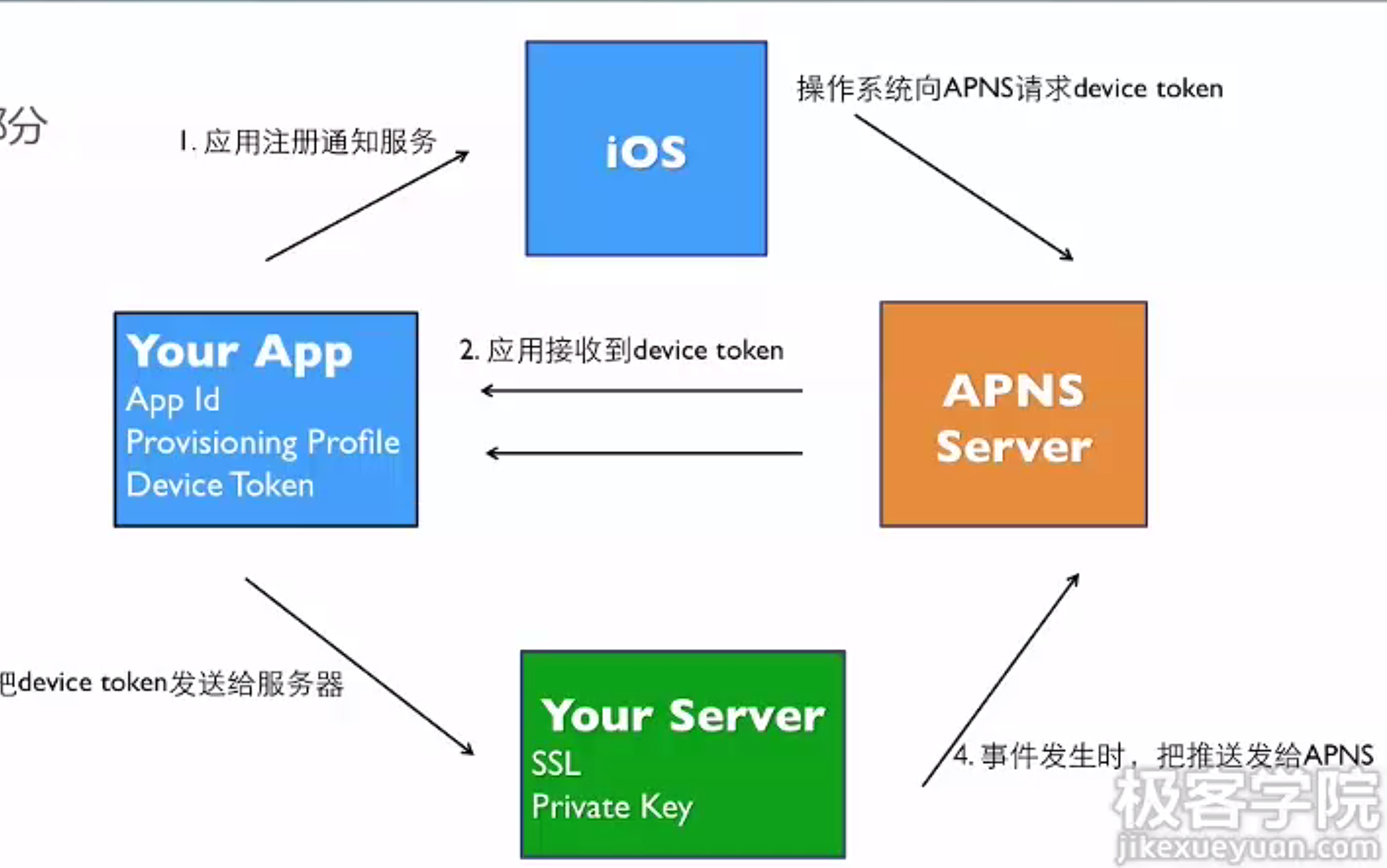推送机制
一,NSNotifcationCenter
观察者模式。KVO。
NSNotification并不能实现IPC,因为NSNotificationCenter只允许同一个程序中的不同对象进行通信,他们不能跨越不同的应用。
Nofitication对象代表Poster与Observer之间的信息载体,该对象包含如下只读属性;
name:代表该通知的名称;
object:代表该通知的Poster
userInfo:
1,注册
1)[[NSNotificationCenter defaultCenter] addObserver:self selector:@selector(mytest:) name:@" mytest" object:nil];
//第一个参数为监听者监听object,第二个参数:监听方法,第三个参数:通知名称;
如果object为空,则用于监听任何对象发出的通知;
[NSNotificationCenter defaultCenter] 获取系统默认的通知中心对象;
2)addObseverForName:object:queue:usingBlock: 指定代码块为监听者;
3)removeObserver:
4)removeObserver:name:object: 取消监听者队指定Poster、指定通知的监听;
2,发送消息
1), [[NSNotificationCenter defaultCenter] postNotificationName:@"mytest" object:searchFriendArray];
2),postNotification:需要一个NSNotification对象作为通知
postNotificationName:object://第一个参数:通知名称;第二个:通知的Poster
postNotificationName:object:userInfo: //第三个参数:是NSDicationary对象,用于携带通知的附加信息;
二,iOS本地通知
1,推送通知的基本目的都是让应用程序能够通知用户某些事情,而且不需要应用程序在前台运行;
区别在于:本地通知由本应用负责调用,只能从当前设备上ios发出;
远程推送通知由远程服务器上的程序发送至App Push Notification serve(APNs),再由APNs把消息推送至设备上对应的程序;
2,本地通知是一个UILocalNotification对象,它有如下属性:
fireDate:指定通知在什么时候触发;
repeatInterval:指定本地通知重复发送的时间间隔;
alertBody:设置本地通知的消息体;
alertAction:设置当设备处于锁屏状态时,显示通知的警告框下方的title
hasAction:设置是否显示Action
alertLaunchImage:当用户通过该通知启动对应的应用时,该属性设置为加载图片
applicationIconBadgeNumber:设置显示在应用程序上红色徽标中的数字;
soundName:设置通知的声音
userInfo:设置该通知携带的附加信息;
UILocalNotification *notification=[[UILocalNotification alloc] init]; if (notification!=nil) { NSDate *now=[NSDate new]; notification.fireDate=[now dateByAddingTimeInterval:10];//10秒后通知 notification.repeatInterval=0;//循环次数,kCFCalendarUnitWeekday一周一次 notification.timeZone=[NSTimeZone defaultTimeZone]; notification.applicationIconBadgeNumber=1; //应用的红色数字 notification.soundName= UILocalNotificationDefaultSoundName;//声音,可以换成alarm.soundName = @"myMusic.caf" //去掉下面2行就不会弹出提示框 notification.alertBody=@"通知内容";//提示信息 弹出提示框 notification.alertAction = @"打开"; //提示框按钮 //notification.hasAction = NO; //是否显示额外的按钮,为no时alertAction消失 // NSDictionary *infoDict = [NSDictionary dictionaryWithObject:@"someValue" forKey:@"someKey"]; //notification.userInfo = infoDict; //添加额外的信息 [[UIApplication sharedApplication] scheduleLocalNotification:notification]; } [notification release];
3,发送通知:
scheduleLocalNotification:该方法指定调度通知。通知将会于fireDate指定的时间出发,而且会按repeatInterval指定的时间间隔重复触发;
presentLocalNotificationNow:立即放松通知,该方法会忽略UILocalNotification的fireData属性;
每个应用程序最多只能发送最近(新)的64个本地通知,超过该限制的通知将被操作系统自动放弃。重复的通知会被认为是一个通知;
如果系统发出通知时,应用程序处于前台,系统将触发应用程序委托类的application:didReceiveLocalNotification:方法;
4,在ios应用中,发送本读通知本地通知的步骤:
1),创建UILocalNotification对象;
2),设置UILocalNotification属性;
3),调用UIApplication的方法发送或调用通知;
4),如果希望应用程序在前台运行时可以对通知进行相应的处理,则需要重写应用程序委托类的application:didReceiveLocalNotification:方法;
三,iOS远程推送通知

UIApplication 提供le如下方法来注册远程Push通知。
-registerForRemoteNotificationTypes:注册远程推送通知;
-unregisterForRemoteNotifications:取消注册远程推送通知;
UIApplicationDelegate中则定义了如下与远程推送通知相关的方法:
-application:didReceiveRemoteNotification:应用程序收到远程Push通知时自动执行该方法;
-application:didRegisterForRemoteNotificationsWithDeviceToken:
-application:didFailToRegisterForRemoteNotificationWithError:




【推荐】国内首个AI IDE,深度理解中文开发场景,立即下载体验Trae
【推荐】编程新体验,更懂你的AI,立即体验豆包MarsCode编程助手
【推荐】抖音旗下AI助手豆包,你的智能百科全书,全免费不限次数
【推荐】轻量又高性能的 SSH 工具 IShell:AI 加持,快人一步
· 如何编写易于单元测试的代码
· 10年+ .NET Coder 心语,封装的思维:从隐藏、稳定开始理解其本质意义
· .NET Core 中如何实现缓存的预热?
· 从 HTTP 原因短语缺失研究 HTTP/2 和 HTTP/3 的设计差异
· AI与.NET技术实操系列:向量存储与相似性搜索在 .NET 中的实现
· 10年+ .NET Coder 心语 ── 封装的思维:从隐藏、稳定开始理解其本质意义
· 地球OL攻略 —— 某应届生求职总结
· 周边上新:园子的第一款马克杯温暖上架
· 提示词工程——AI应用必不可少的技术
· Open-Sora 2.0 重磅开源!